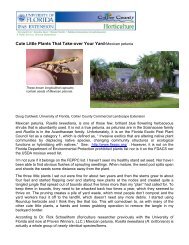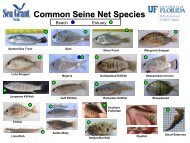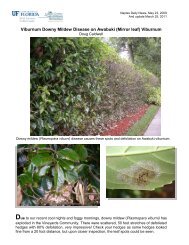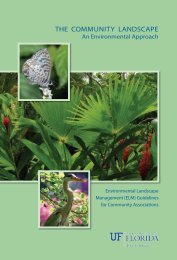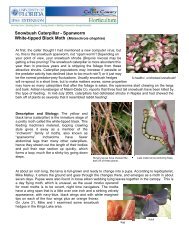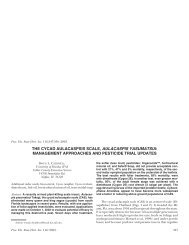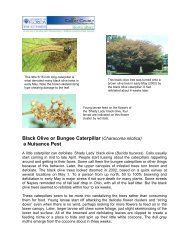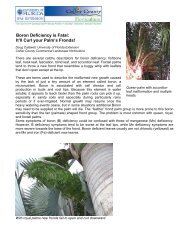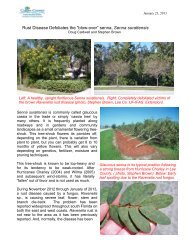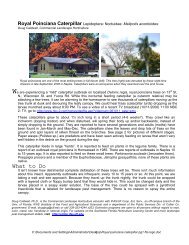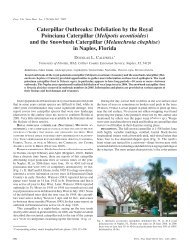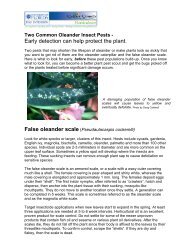bugs shrubs buzz - Collier County Extension Office - University of ...
bugs shrubs buzz - Collier County Extension Office - University of ...
bugs shrubs buzz - Collier County Extension Office - University of ...
You also want an ePaper? Increase the reach of your titles
YUMPU automatically turns print PDFs into web optimized ePapers that Google loves.
EDITION TWO • MAY 2012<br />
Royal palm <strong>bugs</strong> (Xylastodoris<br />
luteolus) are like chinch <strong>bugs</strong> on turf<br />
grass! With their sucking mouthparts<br />
they cause the newest fronds<br />
to have brown areas in April-May.<br />
Although they are not thought <strong>of</strong><br />
as a serious threat, they certainly<br />
can cause considerable aesthetic<br />
damage by their feeding activity.<br />
I’ve had several calls from Marco<br />
Island to Gulf Shore Blvd. and<br />
seen the damage in Port Royal and<br />
3<br />
MORE INFORMATION ON<br />
Whitefly<br />
Rugose Spiraling Whitefly<br />
By Dr. Catharine Mannion<br />
http://tinyurl.com/7x6wbhr<br />
2009 Ficus Whitefly Management<br />
in the Landscape By Dr.<br />
Catharine Mannion<br />
http://tinyurl.com/85m6vvd<br />
Bugs & Shrubs Newsletter 2008<br />
http://tinyurl.com/72exgpo<br />
New Pest Alert Fall 2011<br />
http://tinyurl.com/3qnc2dz<br />
DPI Bondar’s Whitefly<br />
http://tinyurl.com/7qwzout<br />
Palms Under Attack<br />
by Royal Palm Bugs<br />
–Doug Caldwell<br />
PHOTO CREDIT: Lyle Buss, UF<br />
Royal palm <strong>bugs</strong> are almost as<br />
flat as a piece <strong>of</strong> paper and feed<br />
between the closed leaflets <strong>of</strong> newly<br />
emerging fronds.<br />
other areas. Feeding by adults and<br />
nymphs occurs in the spear leaf and<br />
newly expanding fronds. As the<br />
fronds unfurl, the damaged leaflets<br />
are tan-gray, stunted and eventually<br />
become ragged. Damage is heaviest<br />
from mid-March to early July. Damage<br />
by the insects is minimal once<br />
the rainy season starts. Diagnosing<br />
can be tricky. Early damage on<br />
the newest fronds can be confused<br />
with manganese deficiency. Later<br />
in the season as the youngest attacked<br />
fronds droop as they become<br />
the older, lower fronds within the<br />
canopy, the damage resembles<br />
potassium deficiency. This insect<br />
isn’t an “every year bug”, it seems to<br />
have peaks every 15 to 20 years.<br />
What To Do<br />
Merit (imidacloprid) and related<br />
Dr. Dougbug’s Newsletter for Commercial Landscape Horticulture<br />
products (neonicotinoid systemic<br />
insecticides) used as a root drench<br />
have proven effective. For immediate<br />
results crown drenches, usually<br />
applied with an extended low pressure<br />
pole nozzle or from a hydraulic<br />
lift to avoid drift, which would be<br />
unavoidable if they were sprayed<br />
from the ground, may be necessary.<br />
Soil applications should give results<br />
within 30 days. This gives landscape<br />
maintenance personnel more flexibility<br />
since they can wait (depending<br />
on the aesthetic threshold) until<br />
slight damage is observed and then<br />
treat selected palms instead <strong>of</strong>, as in<br />
the past, treating all palms as an insurance<br />
type approach. See this link:<br />
http://tinyurl.com/cz9oa5o<br />
<br />
As the fronds unfurl, the RPB damaged<br />
leaflets are tan-gray, stunted<br />
and eventually become ragged.




